THIS
PAGE IS ALWAYS UNDER CONSTRUCTION, SO PLEASE VISIT AGAIN.
"LA
FORCE PUBLIQUE" OR "DE OPENBARE WEERMACHT" IN
THE BELGIAN CONGO.
the
weapons & uniforms shown in the pictures below are all on display in the
Belgian Royal Museum
of the Army and Military History in Brussels or the Belgian Royal Museum for
Central Africa in Tervuren.
A. Organisation (1885-1918).
The term "Force Publique" was officially used for the first time in a paper dated 30th October 1885, whereby King Leopold II drew the outlines for the Congo Freestate. Actually, it was decided that a "departement C" from the Belgian Foreign Office would be responsable for the Force Publique, its artillery, weapons & ammo. However, the text does not indicate how this should be done in practice and did not change the actual situation. The Force Publique (or "Openbare Weermacht" in Flemish, at that time the second language in Belgium) remained what it was: a number of small armed units at the disposal of the Belgian officlals in the Congo. Early 1886, Léon Roger (a Captain with the Carabiniers) was sent to the Congo with orders to create an armed force. A few months later, on August 17th, he was promoted to "Commandant of the Force Publique". Finally, on 17th November 1888 a paper was issued describing the actual organisation and mission of the force. Next to a General Staff and a "Compagnie de dépôt et d'instruction" (to be located in Boma, where the administration was to be centralised), eight companies, each 100 to 150 soldiers and 40 to 60 military workers were to be created. Their mission was to maintain internal order in the land and to physically occupy each district. This would remain the basic mission of the force throughout its existence. This made it both a military and a police force.
In
1893 the number of companies was doubled, and in 1987 there were already 22.
After the Arab & Mahdist campaigns (1892-94, 1894-98) there was one active
company per district. Meanwhile, several trainingcamps (where basic military
training was instructed) had been created. During the following years, other
specialised units were created: the Kantagese troops, auxiliairy railway-units,
the police corps and military bands.
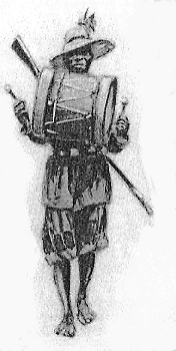 |
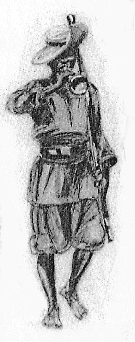 |
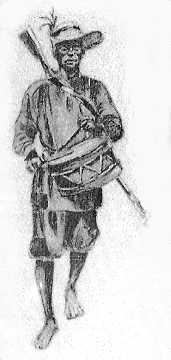 |
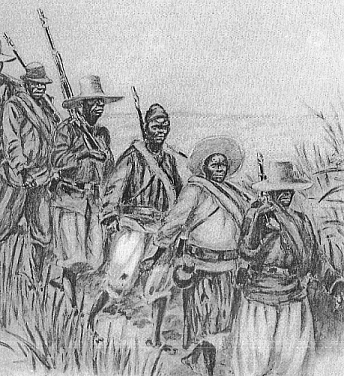 |
|
Force
Publique bandsmen in the northeast of the Congo (1893)
|
Force
Publique askaris in Uélé (1890-93)
|
||
The first soldiers in the Force Publique were Zanzibari and Haoussas; traders from the Goldcoast. Little by little, more and more local inhabitants were recruited (in 1888: 121, in 1891: 702 and in 1892 - after a change in the recruiting system: 2808). The first amongst these originated from the later province of Equator, Ba-ngala. Their mothertongue was li-ngala, to remain the main language spoken in the FP next to French.
Recruitment
was on a regional base. the natives were drafted for a 7 year period: 5 years
in active duty (as from 1900: 7 years) and 2 years in the reserve. The officers
and NCO's were originally all Europeans: some officers from the Belgian Army
next to foreigners (Scandinavians, Italians and Brits), their numbers steadily
decreasing towards the founding of the Belgian Congo (November 1908).
The size of each company varied in proportion to the
needs of the territory it occupied. The Colonel Commandant of the Force Publique
was subordinate to the Governor General of the colony, and the Commandant
of each company likewise reported to his respective District Commissioner.
The colony had recently received a further organization into four large provinces,
and each of these provinces was supposed to have a Major in the Force Publique.
However, in 1914 only two of these positions were filled. These two Majors
were subordinate to the Vice-Governor Generals of the Katanga Province
and the Province Orientale.
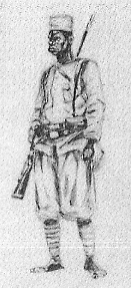 |
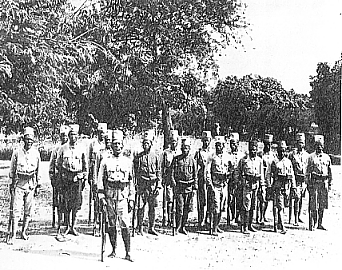 |
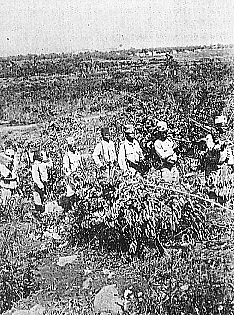 |
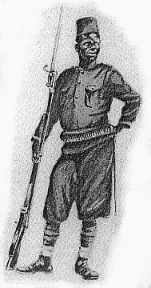 |
|
Force
Publique askari 1916.
|
The
end of the Tabora-campaign. Nearly all these askaris are now in khaki;
only two are wearing blue and one is still in blue trousers.
|
October
1916: attack on Mahenge Hotchkiss MG detail approaching a new firing
position.
|
Force
Publique askari 1916.
|
The
Force Publique numbered some 17,000 men who were obtained through volunteers
and annual levies. General Staff: 50
- each active company between 225 and 950 men strong - 6 training camps: 2400
men - 1
reserve company at Uélé: 225 men
- 1
reserve corps at Lisaka: 150 men
- the
troops in Katanga: 2875 men.
The terms of service were seven years active duty followed by reserve service
of five years (for conscripts) or three years (for volunteers). In 1913 there
were 178 white officers and 235 white NCO's. Only
troops in Katanga were armed with Mausers; the rest had older Albini rifles;
Mauser & FN-pistols for the officers & NCO's. Some Maxim machine-guns
(firing black-powder Albini cartridges) were posted on the frontier (at least
a dozen in the Katanga Province in 1910). There were Nordenfelt 4.7 cm cannons
(20 in Katanga in 1910) and Krupp 7.5 cm howitzers, as well as old 7.5 cm
bronze cannons which had been used in the campaigns against Arab slavers.
The fort at Shinkakasa, commanding the entrance of the Congo River, boosted
eight 16 cm naval pieces. In
retrospect, it was realized that the Force Publique was just a police force.
There were no rear services, commissariat, medical support, or finance service,
and above all no command organization above the company. All of this, of course,
would be necessary to fight a real war...
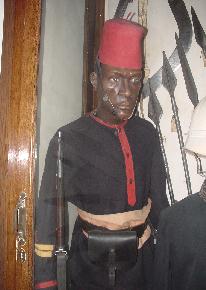 |
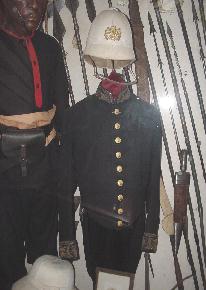 |
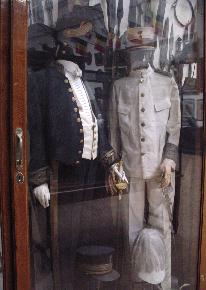 |
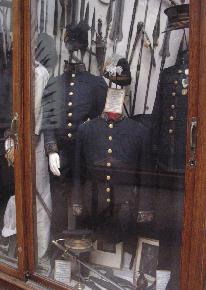 |
|
Corporal
of the Force Publique
in blue uniform. Note: the sash - originally red - has faded. |
Blue
full dress of a Second Lieutenant of the Force Publique.
|
Uniform
of the Vice-Governor General of the Belgian Congo.
|
Uniforms
of (left) the Vice-Governor (centre) Governor & (right) Military
Administrator of the Belgian Congo.
|
|
État-major
de la force publique - Boma. Each district had a company which had platoons and detachments scattered throughout its territory. Below are the district companies and district headquarters where the main part of the company, or at least its commander, could be located. |
||
|
Province
du Congo-Kasai, Province
du Katanga, |
Province
de l'Equateur, Compagnie d'artillerie - fort de Shinkakasa.
Corps de réserve.
Camps
d'instruction: |
Province
orientale,
Corps
de police territoriale: |
Combat
value: the Force Publique was intended to be a policing force only and was
(in 1914) not trained or equipped to do battle with the Germans since the
force did not have a proper command structure, nor logistics or plans for
mobilisation or operations. They were forced into the defence untill these
things could be mended. This would take untill 1916. In 1916, the forces (under
command of General Tombeur) had (in eastern Congo) the following strenght:
- a headquarters;
- a Northern Brigade with two regiments of 3 battalions, each with 2 artillery-batteries,
a company of pioneers/engineers and a telegraph company. Colonel Molitor was
the officer commanding.
- a Southern Brigade with two regiments of 3 battalions, each with one artillery-battery,
a company of pioneers/engineers and a telegraph company. Lt-Col Olsen was
the officer commanding.
- The troops defending Lake Tanganika, the Lake Kivu flottilla, 4 independent
battalions and the service companies.
After
the conference of Dar-es-Salaam (25th july 1917), the "Force Publique"
was deployed as follows:
- headquarters in Dodoma;
- the Southern Brigade in the region of Dodoma-Kilosa;
- the Northern Brigade in Iringa, with the exception of the troops chasing
the raiding party of the German commander Naumann.
During
the war, this police force developped into a military machine that suffered
heavy losses: 9077 dead of which 58 Europeans.
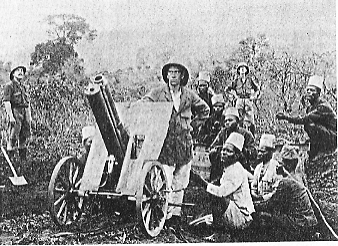 |
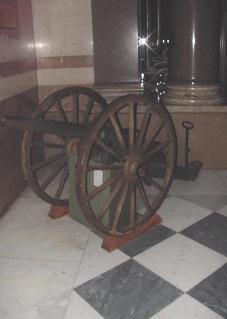 |
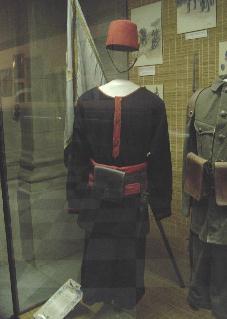 |
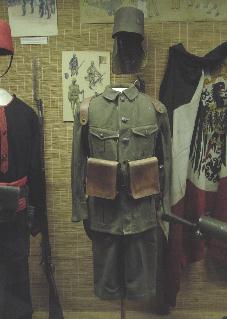 |
|
October
1917 - attack on Mahenge. A 70mm Saint- Chamond gun in position. Note
the poor quality of the khaki dye of fez & jackets, turning white!
|
Nordenfelt
47 mm gun.
|
Force
Publique askari blue uniform.
|
Force
Publique askari khaki uniform.
|